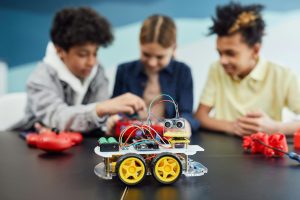The power of peer-to-peer learning in higher education
In the constantly evolving landscape of higher education, traditional classroom lectures and textbook learning are no longer enough to prepare students for the real world. As technology continues to advance, students need to develop critical thinking, problem-solving, and collaboration skills to succeed in their future careers. This is where peer-to-peer learning comes into play.
The concept of peer-to-peer learning
Peer-to-peer learning, also known as collaborative learning or student-to-student learning, is an educational approach where students learn from and with each other, rather than solely from their instructors. It involves students working together in small groups to discuss and solve problems, share knowledge, and receive feedback.
The power of peer-to-peer learning in higher education
In the traditional classroom, students are often passive recipients of information, sitting and listening to lectures without actively engaging in the learning process. This can lead to a disengaged and uninterested mindset, resulting in a lack of retention and practical application of knowledge. Peer-to-peer learning, on the other hand, encourages active participation and student engagement, leading to better learning outcomes.
The collaborative nature of peer-to-peer learning allows students to learn from their peers who may have different perspectives, backgrounds, and skillsets. This diversity sparks critical thinking and creativity as students are exposed to new ideas and challenged to think outside the box.
Enhancing soft skills
In addition to facilitating academic development, peer-to-peer learning also enhances students’ soft skills, such as communication, teamwork, and leadership. These are essential skills that are highly valued in today’s job market and are necessary for a successful career.
Peer-to-peer learning involves students taking an active role in their learning, leading and contributing to discussions, and providing constructive feedback to their peers. This not only improves their own communication and leadership skills but also helps them develop empathy and a sense of responsibility towards their peers.
Fostering a supportive learning environment
One of the key benefits of peer-to-peer learning is the creation of a supportive learning environment. Students who feel comfortable working with their peers are more likely to participate in discussions and share their ideas without fear of judgment or criticism. This inclusivity and sense of belonging can improve their confidence and motivation, leading to better academic performance.
Moreover, in peer-to-peer learning, students learn to work in a team, where everyone’s contributions are valued and vital to achieving the group’s goals. This experience is valuable in preparing them for their future careers, where teamwork is inevitable.
Integrating peer-to-peer learning in higher education
Integrating peer-to-peer learning in higher education can be done in various ways, such as group projects, peer tutoring, and student-led discussions. However, for this approach to be effective, it requires careful planning and facilitation by instructors.
Instructors should provide clear learning objectives, guidance, and expectations to students to ensure that they stay focused and on track. They also play a crucial role in creating a positive and inclusive learning environment and monitoring students’ participation to ensure everyone is actively engaged.
The future of education
The traditional model of education, with its emphasis on rote learning and memorization, is becoming obsolete in today’s society. The power of peer-to-peer learning in higher education offers a more practical and engaging approach to learning, aligning with the skills and competencies needed in the ever-changing job market.
As we continue to embrace technology and adapt to new ways of learning, peer-to-peer learning will become even more prevalent in higher education. By leveraging the power of collaboration and fostering critical soft skills, peer-to-peer learning will continue to shape the future of education and prepare students for the challenges of the 21st century.
In conclusion, peer-to-peer learning is a powerful educational tool that not only enhances academic development but also fosters essential skills for success in the real world. As educators, it is our responsibility to continue exploring and implementing innovative teaching methods, such as peer-to-peer learning, to ensure our students are well-prepared for their future endeavors.











